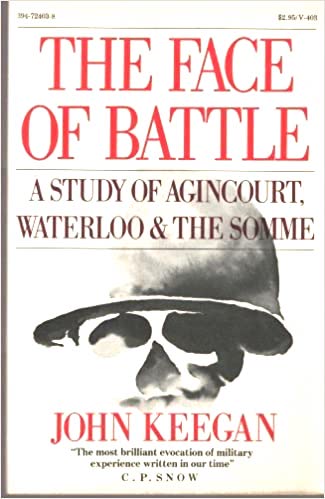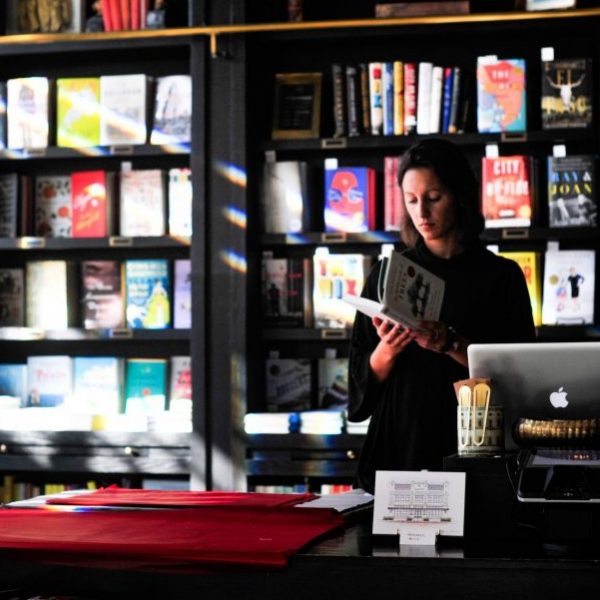A Personal Canon: Nicholas Adams on Five Influential Texts
Why would anyone write a book about the architect Gordon Bunshaft? The consensus is that he was a rude and unpleasant man and, though he was responsible for the design of prominent buildings (Beinecke Library, for one), there’s a chorus of disdain in the background saying that as the chief designer at the architectural firm of Skidmore, Owings & Merrill he was just a big cog in a machine. So why me? My openness to the topic probably goes back to my early academic formation. I started life as a historian of Renaissance architecture and urbanism––and then my interests dispersed. My first job was at Lehigh University and, as the only art historian on campus, I met colleagues in history, urban studies, religion, political science, and––especially––the history of technology. I joined a New York City seminar on the history of technology, and I liked its democratic openness. There was no aesthetic hierarchy, no boundary between “making” and “art,” no arrogance of taste. My Renaissance dissertation had focused on military architecture and dams, so I found a welcoming community. Thus I came to Bunshaft as a historian without the compulsion make an aesthetic judgment––which building was better? which building was worse? To me, Bunshaft was a fascinating problem. My job, as I conceived it, was really to work out why decisions had been taken, how things worked at SOM and what Bunshaft had done to make them work to his advantage. I wanted to explain why people latched on to his buildings in the 1950s and why they had turned against him in the 1970s. People tell me that I have to have a favorite building––as if I was choosing flavors for a macaron––but for me there were so many more pressing questions. How did he reach the pinnacle of power at SOM? How did he deploy his designers? Why did corporations embrace his work in the 1950s? What was he thinking about in his monumental buildings, like the LBJ Library, in the 1970s? Did his relation to his staff change over time? The five books I have chosen are a record of the changes in my thinking over the years––about how I arrived at writing about Gordon Bunshaft.
John Keegan, Face of Battle: A Study of Agincourt, Waterloo, and the Somme (1976)

Keegan’s approach to battle seemed to parallel something that interested me about architecture. Rather than taking an accusatorial approach to warfare and battle (why had this or that strategy failed or succeeded?), he took an inquisitorial approach (why did soldiers adopt this or that strategy?). Effectively, this was the question I wanted to bring to architecture: not whether a work met certain standards of taste but what the architect was trying to do. Keegan was trying to give the young soldiers at Sandhurst an idea of what their experience under fire would be like; effectively, what came to interest me was what decisions architects made based on the situations they faced. Keegan’s approach had much in common with those of my favorite historians of technology and lay behind my work on Skidmore, Owings & Merrill and Gordon Bunshaft. Bunshaft and his team were intelligent, skillful, ingenious, and imaginative: the best and the brightest, even. So how, in the 1970s, did they arrive at buildings that seemed so controversial?
Carl E. Schorske, Thinking with History: Explorations in the Passage to Modernism (1998)

This is not a book of theory––a series of essays about history (what philosophers or theorists do) but rather essays about how to think with history. “Thinking with history,” Schorske writes “implies the employment of the materials of the past and the configurations in which we organize and comprehend them to orient ourselves to the living present.” Schorske’s principles do not mean a selective fishing from the lake for a “usable past,” but an attentive reading of the past in the light of the present––and that connection is truly hard to make. Have I selected just what sparkles from the murky depths? Have I understood my own present sufficiently, orienting myself to the flow of social time and cultural change? Schorske’s capacious intelligence (Mahler, Pugin, Riegl, Loos, Burckhardt are among the subjects addressed in the essays) reminds me to stretch, too. What a help to study late-nineteenth century Vienna, as he did, where everything happened! And to be alert in a time when the so-called rules of modernism were being re-examined! These essays have long pricked me into sharper historical analysis––and stimulated an earlier book I wrote on law and architecture in Gothenburg, Sweden. In the vigorous present, Schorske continues to remind me of the vitality of the past.
William H. Jordy, American Buildings and Their Architects: The Impact of European Modernism in the mid-Twentieth Century (1972)

Like many college and university teachers of my generation, I was just thrown into the deep end for classroom teaching and told to swim. Oh, those poor students. In my first job, I had to teach material I had never studied: the architecture of the twentieth century. (My undergraduate college had allowed me to major in art history taking only courses covering the middle ages and the Renaissance.) True, I had been a student of the great modernist Henry-Russell Hitchcock, but he had been in his Victorian phase when I was in class with him. William Jordy rescued me. In the first place, almost uniquely among historians of modernism, he used his eyes. The skills I had developed looking at the paintings of thirteen-century Tuscany turned out to be more than just useful when it came to modern architecture. Then, too, Jordy connected form to historical processes as well as to developments within architecture itself. Architecture was situated in cultural values and understanding. Buildings and their Architects (all four volumes, including William H. Pierson’s on earlier American architecture) gave me the framework I needed. In short order I discovered his other essays, “The Symbolic Essence of Modern European Architecture” and many others, later collected and republished by Mardges Bacon in 2005. Finally, what still seems generally to be lacking in historical writing about modernism: Jordy wrote to be read. I still reread his work with pleasure. If nothing else, before picking up my pen, it’s a palate cleanser.
Lizabeth Cohen, Saving America’s Cities: Ed Logue and the Struggle to Renew Urban America in the Suburban Age (2019)

Biography is probably near the bottom of the list when it comes to any league table of “serious intellectual forms.” Even in my own field of architectural history, the biography has been routinely disparaged. Though he wrote two of them, James Ackerman was particularly cutting about the limitations of biography. Indeed, biographers do tend to see the world through only one pair of eyes. But I am drawn to biographies because, down deep, people are puzzling. And biographies have a chance to solve (or address) those puzzles. I particularly admire those biographies that sustain an intellectual theme as experienced through the subject. Robert Caro’s biography of Lyndon Johnson is probably the supreme example of the genre––narrowly pipping his earlier biography of Robert Moses. Caro admirably links the short focal length of the journalist with the long view of the historian. Oh, how I wish! Lizabeth Cohen’s study of Edward Logue has similar qualities and provides a model of how the personal story can be combined with deep historical research in the cultural background of an era. There is a lot at stake in a study of Logue, whose work remade the cities of New Haven, Boston, and New York––and not always for the better. Emotions about him still run high––as they do for Bunshaft, or Moses, or Johnson, for that matter; people lather up when his name is mentioned. Cohen steers her history of Logue brilliantly between the personal, the intellectual, and the historical circumstances in which decisions were made. It is to her credit that, after reading her book, we say, at certain moments, Logue made a poor decision with bad results, but given the arguments of the day, we understand how the decision came to be made. The Robert Moses–Jane Jacobs antonym still holds the headlines––but Logue offered something different and should be better known and understood. Cohen shows how illuminating a biography of sympathetic understanding can be when set in the life of its times and connected to our experience of the present.
Carlo Emilio Gadda, Quer pasticciaccio brutto de via Merulana (1957)

My skills in Italian have been nourished by the generosity of Italians willing to listen to me brutalize their language. Reading Gadda, however, has probably been my supreme linguistic achievement. Quer pasticciaccio is a murder mystery without a solution investigated by a detective convinced that there is no such thing as “a cause,” but only “causes.” Told in a tangle of dialects (Italian standard, romanesco, molisano, napolitano) the novel reminds us (historians especially) that there is no such thing as a “key” to our puzzles, only “keys,” that there is no “lock” to open, only “locks” to examine. And these objects, as they must, become the focus of our speculation. Gadda’s fascination with language, his ability to turn phrases over, to reconsider the shades of their meaning, is magical––almost as compelling as research itself. And the city of Rome, in all its variety, is one of the protagonists of the story. Though the novel has been translated into English as That Awful Mess on Via Merulana, by William Weaver, the greatest of translators from the Italian, much escaped his grasp, as he surely knew. Even those with a modicum of Italian can appreciate the beauty of the text by listening to it (on Audible) and following along with the English translation as I did at times. The last word in the book, “quasi,” or “almost” represents the kind of humility I try to adopt as a historian. And by humility I do not mean self-effacement for that would be inconsistent with the act of writing history but, to quote Iris Murdoch, I mean a “selfless respect for reality,” as hard an undertaking as there is.
Nicholas Adams is professor emeritus of architectural history at Vassar College and the author of Gordon Bunshaft and SOM: Building Corporate Modernism.

Bibliography
Lizabeth Cohen, Saving America’s Cities: Ed Logue and the Struggle to Renew Urban America in the Suburban Age (New York: Farrar Strauss & Giroux, 2019).
Carlo Emilio Gadda, Quer pasticciaccio brutto di via Merulana (Milan: Aldo Garzanti, 1957).
William H. Jordy, American Buildings and Their Architects: The Impact of European Modernism in the mid-Twentieth Century (New York: Doubleday, 1972).
John Keegan, Face of Battle: A Study of Agincourt, Waterloo, and the Somme (London: Jonathan Cape, 1976).
Carl E. Schorske, Thinking with History: Exploration in the Passage to Modernism (Princeton: Princeton University Press, 1998).




